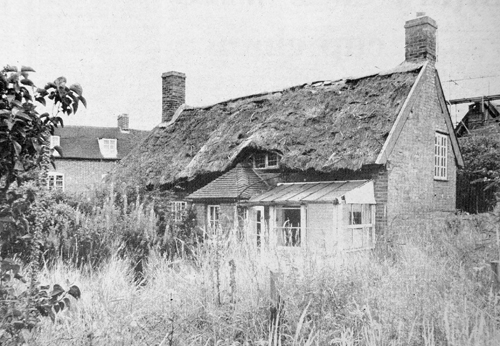Raleigh’s Potato Patch
(Published KWN, 6th October 2010)

One of the ‘Little Virginia’ cottages, shortly before restoration in 1972. (Copied from the ‘Kenilworth Weekly News’.)
From town guides, serious historical works, the official town website and others advertising housing, restaurants, and places to stay, we can read that – “Walter Raleigh planted the first potatoes in England at Little Virginia”. There is also a variation on this story: Raleigh supplied potatoes for one of Queen Elizabeth’s visits to Kenilworth Castle, she took a bite (mistakenly from a raw one), threw it out of the window, and a small boy picked it up and planted it nearby. Is it possible there is truth in one version of the legend?
The most recent archaeological surveys, carried out by the Kenilworth History and Archaeology Society in 1973, concluded that none of the Little Virginia cottages is likely to pre-date the 17th century. There was also largely un-datable evidence suggesting the site had previously been used for stone working and so in Raleigh’s days, the late 16th century, the area may have been an open space strewn with stone chippings.
There are claims that it was actually Sir Francis Drake who introduced potatoes to England in 1586. His voyage that year took in South America, where the potato originated, and the British colony set up in Virginia under a charter issued to Raleigh. It is thought that the first potatoes at the Virginia settlement arrived from this Drake voyage. Drake then returned to England, and it is suggested that he may have brought potatoes with him. Raleigh himself never set foot in Virginia.
The following year, 1587, a close colleague of Raleigh’s named Hariot, a botanist who had been instrumental in setting up the Virginian colony, took potatoes to Raleigh at his home in Ireland; it is now generally accepted that these were probably the first planted in the British Isles.
Although the origin of the first potatoes actually in England is still debated, we can safely assume that the first planting would be soon after 1587. As Queen Elizabeth’s final visit to Kenilworth was in 1575, her involvement suggested above can thus be discounted.
Raleigh at the time owned, or had use of, a number of properties throughout England. With these at his disposal, it seems unlikely that he would have preferred to come to Kenilworth, a place with which he had no known links, to grow some of his very rare plants in such a public place – a corner of a field, possibly strewn with stone chips, alongside a road near the castle.
The odds are clearly against the legend of Raleigh having substance in truth, but this still begs the question, why the name ‘Little Virginia’?
A number of the early colonists returned to England from Virginia and a Victorian historian has suggested that some of these may have settled in Kenilworth (a couple of family names apparently coincide), made their homes and called them ‘Little Virginia’; the 1973 survey’s conclusion that the cottages were built in the early 17th century could support this. The original colonists were linked to Raleigh, and any later settling in Kenilworth could have brought potatoes here with them; is this the origin of the legend?
There is one additional curiosity at the end of this tale, for Little Virginia is not the only place in Kenilworth to carry a name from across the Atlantic; nearby was an area once known as California. Unfortunately, there is no local folklore to help with this one!